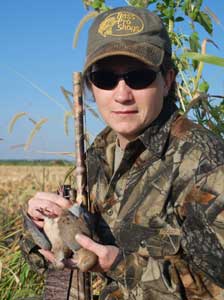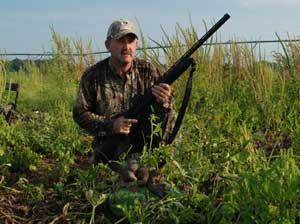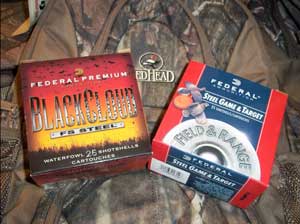
Autumn is that all too short season between late summer and fall. Dear to the hearts of shotgunners, autumn is a magical time in the field. It is a time of harvest for farmers and hunters alike. Slightly cooler mornings create an excitement among those who pursue the birds of autumn – those first flights of blue-winged teal, stirred to migration by northern breezes and those gray ghosts of the fields, the morning dove.

"I look forward to early September every year," said avid shotgunner Rick Ply, from Missouri. "Dove and teal seasons are a ton of fun, but serve as the introduction to more hunting seasons to come."
The early seasons never last long enough, but are a much welcomed beginning. It is a great experience to get away from the cares of everyday life, take the dog out and attempt to down a few doves or teal. Both are extremely fast flyers and unless you are an expert shot, will soon have you laughing at yourself and your buddies. These birds dupe even the best shooters with their aerial acrobatics.
Morning doves are the most populous game bird in the United States, and most states have a season, which usually begins around the first of September. And the good news for hunters is that doves are holding their own in most regions of the country.
Where to Find Doves
Doves are found in a variety of habitats, from city parks to open farm regions. They are ground feeders, eating weed seeds and waste grains. However, doves have very weak feet and do not scratch to find food. They must have bare ground to look for their food sources. Understanding this factor is key to looking for a pace to hunt doves.
Cut grain fields such as corn, milo and soybeans are prime dove hunting spots. The crops are harvested and tall stalks are chopped up and scattered on the ground. Even the modern farm machinery of today still spills a good amount of grain on the ground, making it available to doves and other animals.
A little scouting before the season opener, goes a long way towards helping a hunter pick a spot on any given field to set up on. All spots are not created equal.
Doves often enter and leave a field at selected spots. Those spots are where a shooter should set up. Such spots include corners where there may openings between trees bordering the field. These openings may occur in the middle edges of a field as well. Power lines and other right of way cuts, entering a field give birds a travel path to follow as well.
A favorite of many hunters is a fencerow with a few dead trees in it. The fencerow acts as highway for the birds and the dead trees are perfect roosting and resting spots. A shallow ditch or or low spot crossing a field may also serve as a travel corridor.
Small ponds and lakes with bare ground banks are dove hunting hotspots as well. Birds must have water and they come to the ponds to pick up grit as well as to quench their thirst. However, larger ponds should be thoroughly scouted. Birds will have preferred entry points to the pond.

Farm feed lots and mellon fields are other places to find concentrations of doves. Feed lots contain a great deal of waste grain and mellon fields offer a grand variety of weed seeds. If you find a mellon field that has dried up melons or has been disked, you are in for a bonus hunt. Doves flock to such easy access to seeds.
Hunting Blue-Winged Teal
Blue-winged teal are the earliest of the duck migrators. Weighing in at about 6 ounces, these diminutive ducks zoom across decoy sets at 60mph, duping even the best of wing shots. Teal follow all of the major flyways south as they head to wintering grounds in the southern U.S., Mexico and South America. They prefer shallow water areas to stop to rest and feed, before continuing their flights.
Teal numbers have exploded in the last couple of years. Populations are 70-percent above the long term average from when counts were first started by U.S. Fish and Wildlife biologists in the early 1950s. There has never been a better time to try teal hunting.
Teal are easily decoyed. Several companies make teal duck decoys, but they will readily decoy to any species of decoy. "I use my regular mallard decoys for teal," said Ply. "If teal see your decoys, they are going to set down in them, many times on the very first pass."
Teal hunts are a great time to bring your young hunters along. The birds often plop down in the decoy set. It is great fun to flush the birds to give young hunters straight away shots. However, it is a thrill of a lifetime for a youngster to down a teal zooming across the decoys. That is the moment when young gunners graduate into the "bragging rights society."
Tricks to Down Dove and Teal Ducks
Both dove and teal ducks are formidable targets and can create great frustration for shotgunners. RedHead Hunting Pro Staff member Allen Treadwell offered some sound shooting advice:
"It is easy to get frustrated with these fast flying birds. The first thing shooters should do is pattern their shotgun. You need to know where your shot pattern is impacting compared to where you are aiming. Get a 3-by-3 foot piece of cardboard; make a golf ball sized bull's eye on it. Back up 30 yards. Focus hard on the bull's eye, not the barrel of your shotgun. Raise your shotgun, point it at the target and shoot. Remember, to use instinctive shooting with a shotgun. You point and shoot, not aim and shoot. Do this 3 times to establish the pattern of your gun. If it is way off center, you may need to see a gunsmith to help correct the problem."

teal and number 7’s for dove are standard.
Treadwell pointed out a second major problem for shotgunners after the birds of September. "Hunters often put the wrong choke in their guns. Many use the full or modified chokes for dove and teal," he said. "These birds are easy to kill, but very hard to hit. Opening up the choke will greatly increase your success rate. Use your improved cylinder."
Practice shooting as well. Sporting clays ranges are superb skill builders. And when you hit the field, Treadwell advises shooters to concentrate on the head of flying birds. "Don't look at the whole body of the bird. The old adage of 'aim small, miss small' is very true."
Another tip to remember is that both dove and teal are light weights. Doves will weigh 4 ounces or less and teal seldom top 6 to 8 ounces. You don't need a canon to bring them down. Both light guns and light loads are sufficient for these game birds. Both your shoulder and your wallet will appreciate their usage.
Companies such as Benelli, Beretta, Browning and Remington make lightweight shotguns which handle well and still get the job done. Loads of 1-to-1 and 1/4 ounces of No. 7 and 1/2 shot are ideal for doves. Two and 3/4 inch magnums in number four shot are ideal for teal.
When you sense a change in the air near the end of summer, and the walnut leaves begin to yellow, autumn is arriving. It's time to enjoy the fastest shooting action you will experience all year long. Break out your gear and chase the birds of autumn.
- 6155 views

